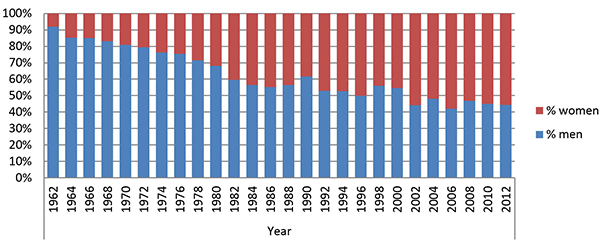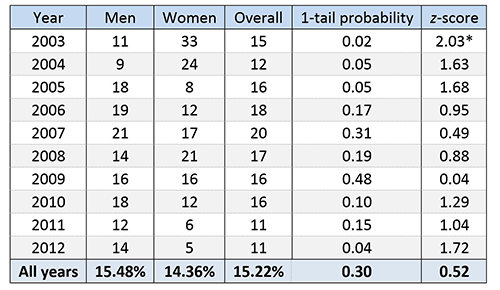Is There a Gender Gap in the Perception, Action, and Cognition Program at NSF?
When academics, legislators, media outlets, and the general public raise concerns about women’s underrepresentation in science, technology, engineering, and mathematics (STEM) fields, they often describe the issue in generalities. This tendency can be deceptive, as there are vast differences among the many STEM disciplines. In more nuanced discussions, engineering and computer science often are derided for having the lowest rates of participation by women (possibly even declining from 1980s participation levels). Although it may be tempting to point fingers at other fields, psychological scientists should resist the urge to be smug about the gender balance in our own field. Despite psychology often being touted as the model STEM field for gender parity, a closer examination reveals that academic and research institutions employ disproportionately fewer female than male PhDs in the subfields best represented by the National Science Foundation’s Perception, Action, and Cognition (PAC) program.
So what exactly is the current level of gender equity in the PAC research community? Are women and men equally successful at having grant proposals awarded in the PAC program? To answer these questions, we can’t simply compare the number of proposals awarded; we also need to relate these numbers to the distribution of men and women in academic and research positions in relevant areas of psychology. Are we performing better than, worse than, or the same as the field as a whole?
The National Center for Science and Engineering Statistics (NCSES) at NSF provided useful data. We first looked at their Survey of Earned Doctorates (SED) and determined that its “cognitive” and “experimental” subfields of psychology are closest to those areas funded by PAC (although the SED omits other PAC-funded areas of study, such as motor control and coordination). We included both “cognitive” and “experimental” psychology because the latter term progressively morphed into the former in the early 1980s. Figure 1 shows the percentage of men and women receiving PhDs in cognitive and experimental psychology at US institutions over time.

Figure 1. From the NCSES Survey of Earned Doctorates, National Science Foundation (2015). PhDs graduated in cognitive/experimental psychology by gender over time.
Although few women received doctorates in these fields in the 1960s, the proportion of women in cognitive and experimental psychology has steadily increased since then. Women earned a mere 8% of the doctoral degrees granted in 1962 but earned nearly 56% of doctorates in cognitive/experimental psychology granted in 2012. This increase reflects the trend in many fields, where women now outnumber men in graduate studies. But receiving a PhD is only the first step in a research career. How do women fare once they leave graduate school?

Table 1. From the NCSES Survey of Earned Doctorates, National Science Foundation (2015). Data were not collected for the intervening years.
To answer this question, we again used data from the Survey of Earned Doctorates (from US institutions) to determine where cognitive psychologists were employed after they left graduate school. We found that women are greatly underrepresented in academic research institutions relative to the number of earned doctorates. “Academic research institutions” include 4-year colleges and universities, medical schools, and university-affiliated research institutes — the places where most submissions to PAC originate. In the most current year for which data are available, 2010, only 33% of the cognitive/experimental psychologists employed in academic research institutes were women, as shown in Table 1.
This large gender discrepancy has troubling implications for the PAC program, as it raises the question of whether or not men and women are submitting research proposals to the program at equal rates. A study conducted at Harvard Medical School reported that women faculty members submit research grants at a far lower rate than do male faculty members (Waisbren, 2008). A report issued in 2009 concluded that from 2006–2009, women submitted less than half as many applications to the PAC program as did men. Although current submission data to PAC are not publicly available, this discrepancy in submissions by male and female principal investigators has likely continued.
As there is usually a gap between when researchers receive their degrees and when they begin submitting research proposals, and as the proportion of doctorates earned by women in cognitive psychology is increasing, we may expect that the number of women in the PAC research community will continue to increase. This expectation is consistent with the findings of the Harvard study, in which the imbalance in grant submissions by female and male faculty decreased as faculty members moved up the ranks.
In addition to looking at submission rates, it is important to examine proposal success rate by gender and by year (Table 2) to assess whether funding rates are equitable. The small number of awards made on a yearly basis means that success rate by gender varies from year to year. Despite the variable yearly success rate, only 2003 showed a statistically significant difference between men’s and women’s success. This is extremely important to us at NSF, as we strive to fund studies with the highest intellectual merit and broadest impact while recognizing the importance of broadening participation of all groups underrepresented in science.

Table 2. Percentage of PAC proposals awarded by principal investigator gender and year.
We now know that although women are receiving more doctorates in cognitive psychology and are receiving NSF funding with a success rate equivalent to that of men, they lag behind men in research grant submissions. Why is this? And how can we fix the problem?
Research has attributed women’s underrepresentation in STEM to a variety of causes (Valian, 1999), including discrimination, implicit bias, impostor syndrome (women being unable to internalize their accomplishments), lack of mentorship and resources, and lifestyle constraints (such as being the primary caregiver to young children and having responsibility for the lion’s share of household chores). With such a complex issue, it’s most likely a constellation of factors that influence which women end up in STEM fields, which ones thrive, and how they do so.
One reason women may be less apt to apply for grant funds may be related to lack of confidence (Young, 2011) and a by-product of low confidence: inaction. For example, women typically score worse than men on spatial puzzles, in part because women provide answers only when they feel relatively confident that they are correct. When women are told that all of the puzzles have to be answered, correctly or not, their scores increase sharply and match the men’s scores. But when the subjects are asked to report how certain they are of their answer, women’s scores significantly worsen, whereas men’s scores increase (Estes & Felker, 2012). Over the past few years, there have been frequent reports concerning possible cuts in funding to the social and behavioral sciences and consequent decreases in success rates for proposals. These reports may differentially affect female scientists’ confidence in their proposals, leading to inaction (e.g., not submitting the proposals in the first place).

Table 3. Expenditures for PAC sciences, 2012–2014.
Perhaps the following statistics will help increase women’s confidence and actions. Although the base budget of the PAC program has remained flat over the past few years (slightly less than $7 million per year), the program directors have successfully leveraged other sources of funding within NSF to support our sciences. Table 3 shows funds spent on PAC awards from all NSF sources over the past 3 years. The numbers were extracted from the awards database available on the NSF.gov website and provide only a rough picture of PAC spending. Nevertheless, they give a good sense of funding levels for our sciences, over and above what the PAC program can provide on its own. The amounts include co-funding from other programs (reflecting the interdisciplinary nature of much of our science), funds expended in related areas of emphasis (e.g., “Dear Colleague” letters for forensic sciences and for computational cognition), and cross-cutting initiatives such as INSPIRE (www.nsf.gov/publications/pub_summ.jsp?ods_key=nsf14106). The funding situation will likely improve with our field’s participation in the Understanding the Brain Initiative at NSF (e.g., “Integrative Strategies for Understanding Neural and Cognitive Systems” at nsf.gov/ncs).
One avenue by which NSF contributes to our understanding of gender and STEM is through the Science of Broadening Participation (SBP) — an investment in research that draws heavily from social and cognitive psychology (along with numerous other fields) to investigate the influences on an individual’s participation in STEM (see www.nsf.gov/pubs/2014/nsf14038/nsf14038.pdf). In essence, SBP funding may encourage researchers to draw on some of the theoretical and methodological advances of psychological science and turn the lens back on the field itself.
As the SBP program specifically addresses the potential causes of gender imbalance, the NSF also strives to provide relevant mentorship and support through our outreach efforts. Many professional societies also have websites, interest groups, and special networking opportunities aimed at women and other underrepresented groups. Perhaps the data presented here will act as a catalyst for other efforts to facilitate gender equity in the funding process and in the professoriate. For our part, we can encourage all scientists to submit their best ideas to NSF. The only way to ensure that you will not be funded is to fail to submit a proposal.
Acknowledgments: The authors would like to give great thanks to John Finamore of the National Center for Science and Engineering Statistics for providing data used in this article.
Any opinions, findings, and conclusions or recommendations expressed in this material are those of the authors and do not necessarily reflect the views of the National Science Foundation.
References
Estes, Z., & Felker, S. (2012). Confidence mediates the sex difference in mental rotation performance. Archives of Sexual Behavior, 41, 557–570. doi: 10.1007/s10508-011-9875-5
National Science Foundation, National Center for Science and Engineering Statistics. (2015). Women, minorities, and persons with disabilities in science and engineering: 2015. Arlington, VA: Author. Retrieved from http://nsf.gov/statistics/wmpd/
Valian, V. (1999).Why so slow? The advancement of women. Cambridge, MA: MIT Press.
Waisbren, S. (2008). Gender differences in research grant applications and funding outcomes for medical school faculty. Journal of Women’s Health, 17, 207–214. doi:10.1089/jwh.2007.0412
Young, V. (2011). The secret thoughts of successful women: Why capable people suffer from the impostor syndrome and how to thrive in spite of it. New York, NY: Random House.





APS regularly opens certain online articles for discussion on our website. Effective February 2021, you must be a logged-in APS member to post comments. By posting a comment, you agree to our Community Guidelines and the display of your profile information, including your name and affiliation. Any opinions, findings, conclusions, or recommendations present in article comments are those of the writers and do not necessarily reflect the views of APS or the article’s author. For more information, please see our Community Guidelines.
Please login with your APS account to comment.